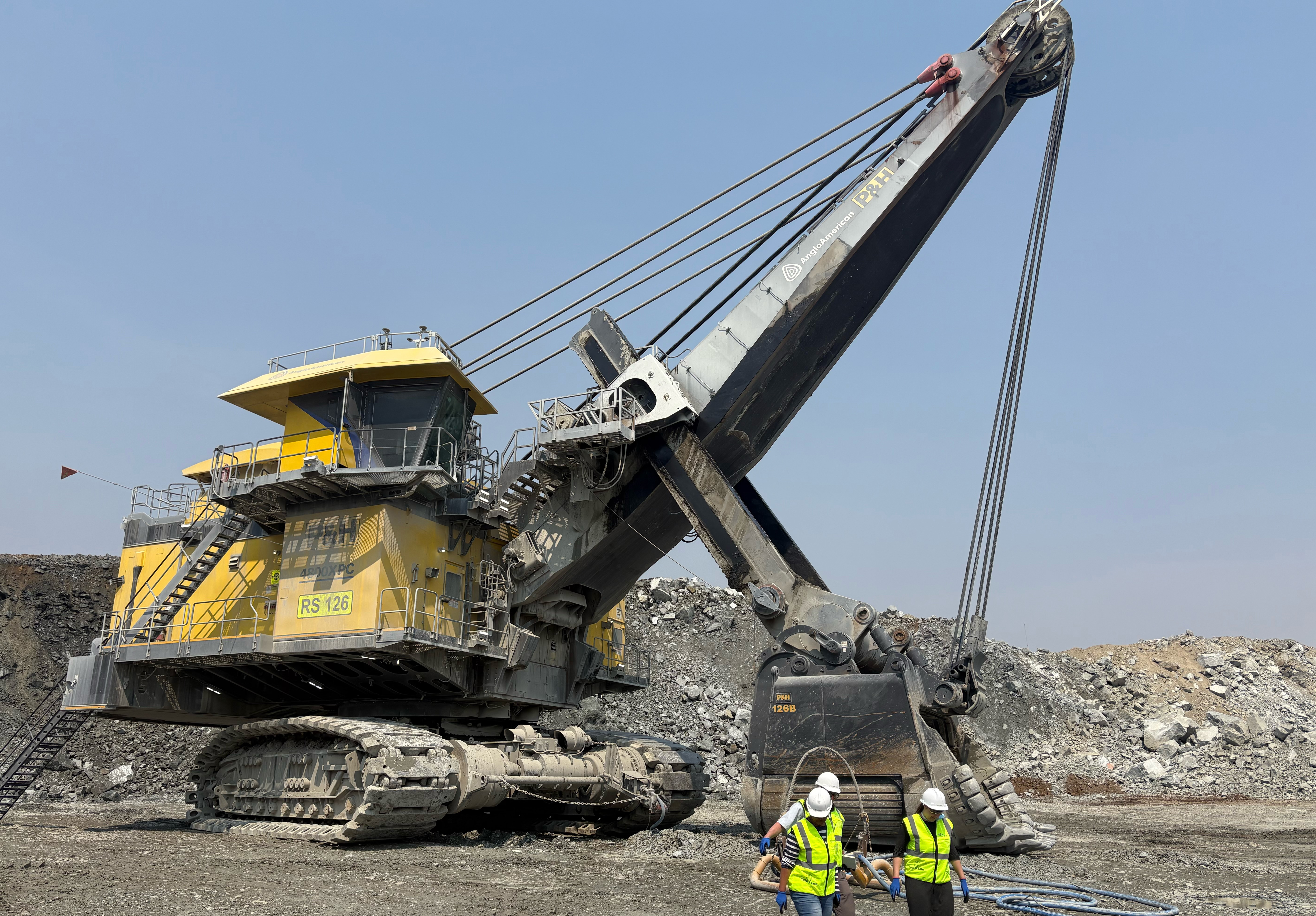Like a hulking Jurassic giant, the mechanical monster digs into the wall of smashed rock. It then pivots its boom sharply to the left, allowing the dipper extending from it to deposit a load of platinum-bearing ore into the back of a titanic truck.
/file/dailymaverick/wp-content/uploads/2025/08/IMG_1659.jpeg)
/file/dailymaverick/wp-content/uploads/2025/08/IMG_1689.jpeg)
Three scoops and swings of the boom are enough to load the truck with an astonishing 300 tonnes – the weight of about 60 adult male African elephants. Rinse and repeat, and a truck to the right of the creature is also loaded and ready to lumber out of the pit.
Welcome to the world of 21st-century open-pit platinum mining, where size matters and the sheer scale is literally earth-shaking. Think of a larger and mechanised version of the brontosaurus Fred Flintstone bestrode in the rock quarry where he plied his stone-age blue-collar trade.
This mechanical wonder is plying its trade at the Mogalakwena Mine in Limpopo, owned and operated by Valterra Platinum, which spun out of the Anglo American stable in May this year. Mogalakwena is the world’s largest open-pit platinum mine.
The technical term for the machine in question is a “rope shovel”, though it seems a stretch to think of it as a rope-guided shovel. The model is the Komatsu P&H 4800, and it is the largest of its kind in the world. The boom hovers more than 20m above the ground.
/file/dailymaverick/wp-content/uploads/2025/08/IMG_1681.jpeg)
style="font-weight: 400;">the other is in Canada. Commissioned by Valterra when it was still part of Anglo in April last year, the price tag is an eye-popping R750-million – equivalent to around 750 Ford Raptors.
“You need big machines for big tonnages,” said Willie Theron, the executive head of mining operations at Valterra. While it now extracts ore, its main job will be the weightier one of stripping off waste rock.
In the belly of the beast
On a media tour of the mine on Wednesday, 27 August, journalists were invited into the belly of the beast.
A 10m climb up stairs leads to the operating control cabin, where 14 people, including the operator, managed to squeeze inside.
The operator, an affable chap named JP Nel, uses two joysticks to control the beast.
“It’s like a video game,” he said with a chuckle.
When the beast rumbled to life, the control room jarringly rattled. The dipper then clawed into the rock. Hoisting its load, the machine swung to the left to dump its cargo on to the back of a truck.
Three video screens lie to the left of the operator, and among the things they signal is the precise weight of the load – one was around 120 tonnes.
A bit of debris can fall by the wayside and the truck sends a message back to the beast, detailing the exact weight that has been dropped. It’s all very hi-tech, which one would expect for R750-million.
Big capital, hi-tech
This “rope shovel” underlines a number of points about the mining sector on both the South African and global stages.
One is the constant drive to mechanisation, digitisation and automation – and to bigger and better machines to boost efficiency. At Mogalakwena, innovations such as the beast speed up the loading process, ultimately cutting unit costs per tonne while reducing the size of the truck fleet.
/file/dailymaverick/wp-content/uploads/2025/08/IMG_1672.jpeg)
It also shows that while much of the narrative around South African mining is about decline, many companies are still investing significant capital into their operations. You don’t splash out R750-million on a toy if you are not in it for the long haul, and Mogalakwena has an economically viable reserve life of 86 years. So it is expected to be operating into the 22nd century.
Mining is becoming increasingly hi-tech and capital-intensive. This is a trend mirrored in the agricultural sector, where innovations such as precision farming – which allow for the precise application of inputs through GPS technology – are also leading to bigger machines and improved yields.
In the process, activities such as artisanal mining and rain-fed subsistence farming are falling further behind.
Aside from increased productivity and hence profits, such trends are also making mining safer while simultaneously reducing the workforce, which is becoming more skilled.
Perhaps in a few decades, the beast may seem almost as archaic as Fred Flintstone’s brontosaurus. Today’s technology is tomorrow’s dinosaur. DM




 The beast of Mogalakwena Mine, Limpopo — a Komatsu P&H 4800 rope shovel, the largest of its kind in the world. (Photo: Ed Stoddard)
The beast of Mogalakwena Mine, Limpopo — a Komatsu P&H 4800 rope shovel, the largest of its kind in the world. (Photo: Ed Stoddard)